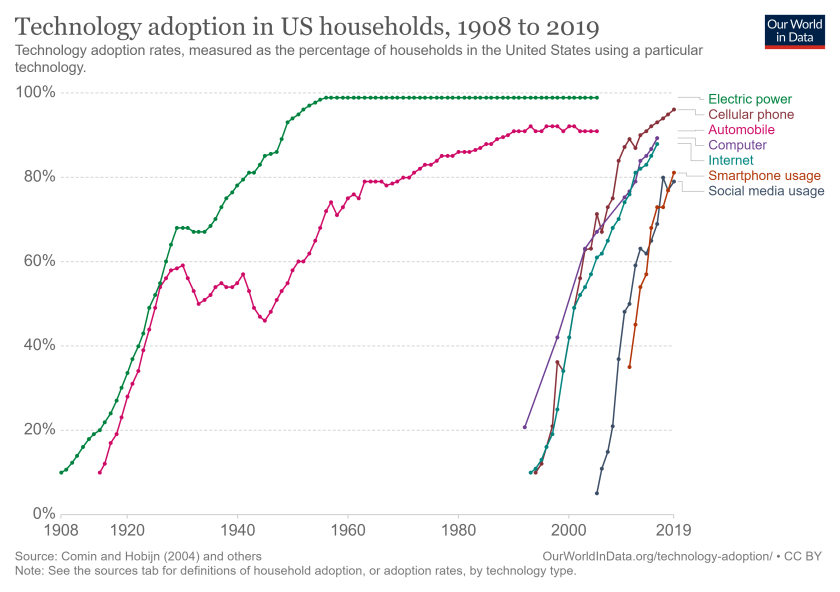The pace of technology adoption is getting faster and the time period for a new technology to become mainstream is getting shorter. What will be the consequences of this in the long run is hard for most of us to imagine since we are inside this whirlpool of change and secondly, we are not good at foreseeing changes which compound at a long time horizon. As has been said, “we underestimate the effect of technology in the short run and underestimate it’s effect in the long run“. This quote is attributed to Roy Amara, a Stanford based scientist, futurist and researcher and it means that humans almost always tend to overestimate the effect of a new technology in the short term and underestimate what the effect of that new technology will be in long term. This is because we are biased towards thinking in linear terms and struggle to comprehend exponential growth which is the trajectory associated with respect to adoption of technology (and also growth of money based on compound interest as famously advocated by Warren Buffet and in growth of computation power as mentioned in Moore’s Law, read more on exponential growth in an excellent essay at the Farnam Street site – ‘Gates Law: How Progress Compounds and Why It Matters’).
I was reminded of this quote from Roy Amara when I came across the website, ‘Our World in Data’ which has fascinating graphs and data on the adoption of various technologies going back to 20th century. The website has an interactive graph and you can spend hours if you have time to kill to pull in various technologies and see their spread of adoption from 1910 to present time. I pulled a few and as can be seen in the figure below the pace of technology adoption is getting shorter; it took 40 years for electrical power to be present in 90% of US households but only 24 years for computers and 10 years for social media usage.
For example as shown in the graph below,

- Cars (74 years) – automobiles took 74 years to be present in 90% of US households; around 1915 only 10% of households had at least one car and by 1989 a car was there in 90% of US households. Car ownership had two periods of decline around the Great Depression from 1930 to 1933 and from 1941 to 1946.
- Electricity (40 years) – given that electricity is a more basic need than cars it took a shorter period of time (40 years) for electrical power to penetrate 90% of the US households; electrical power was in 10% of US households in 1908 and it was there in more than 90% of US households by 1948.
- Computers (24 years) – computers took 24 years roughly to be present in 90% of the households from 1992 to 2016. At the launch of the twentieth century, such a short time period could never have been imagined and not just to laymen but even to IBM who did not see the potential to launch the personal computer first and Microsoft and Apple took the leap and the rest is history.
- Color TV (20 Years) – Color TV took slightly less time of 20 years to achieve that same level of penetration as computers; in 1966 it was in 10% of US households and by 1986 it was in more than 90% of households.
- Cellphone (20 years) and SmartPhones (8 years) – Interestingly, cellphone had the same time period of adoption as color TV from being at 10% in 2013 to 90% by 1994. However smartphone usage had a drastically shorter time period of adoption and more than doubled in just eight years from 35% at 2011 to 81% by 2019.
- Social Media Usage (10 years) – social media being the latest technology had a shorter time period of adoption and it took only 10 years to be present in 79% of households starting from 10% in 2006.
What will be the consequences of this faster and faster pace of technology adoption and the exponential growth in their pervasiveness?…………..


One comment